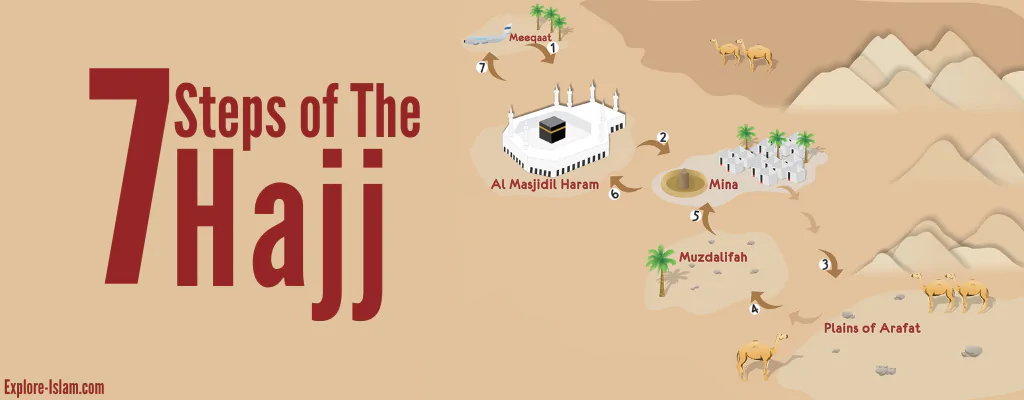Hajj is the fifth pillar of Islam and a sacred journey that embodies ultimate obedience, servitude to God, patience, and submission. It is one of the most profound acts of worship in Islam, required once in a lifetime for every capable Muslim. Though obligatory only once, it can be performed voluntarily multiple times.
In this comprehensive guide, we will answer the most essential question: How to perform Hajj step by step. We will break down the Hajj rituals in order, explain each step with clarity, and guide you through the exact process of performing Hajj, including its timing, purpose, and detailed rites. Let’s begin your journey to understanding the Islamic pilgrimage.
Hajj Rituals: 7 Steps of the Hajj in Order
Hajj rituals are derived from the Sunnah (the practical application) of Prophet Muhammad (PBUH) and must be carried out in a specific time, place, and sequence. Below is a concise overview of the seven essential steps of Hajj:
- Entering the State of Ihram
- Performing Tawaf and Sa’y
- Spending the 8th of Dhul-Hijjah in Mina
- Standing in Arafat on the 9th
- Staying overnight in Muzdalifah
- Stoning the Jamarat in Mina
- Performing Eid al-Adha rituals, including sacrifice, shaving, and farewell Tawaf
The following image highlights how to perform Hajj through the steps of Hajj based on places of rituals:

Let’s explore these rituals in more detail through a step-by-step guide:
How to Perform Hajj? Step-by-Step Guide
Hajj is a profound act of worship involving a series of sacred rites performed in and around Mecca. Here’s a detailed breakdown of how to perform Hajj:
1. Entering the State of Ihram
Before crossing the Miqat (designated boundary around Mecca), pilgrims must enter the state of Ihram, marked by specific clothing and the sincere intention to perform Hajj. This spiritual state involves purity, prayer, and avoiding certain actions:
- Men wear two white unstitched cloths, symbolizing unity, humility, and equality.
- Women wear modest clothing that fulfills Islamic guidelines without a specific uniform.
There is no distinction of race, status, or nationality—a reminder of the Day of Judgment when all stand equally before Allah.
For more about Ihram, read these articles:
2. Performing the Arrival Tawaf
Upon entering the Grand Mosque in Mecca, pilgrims begin with Tawaf al-Qudum:
- Tawaf involves walking counter-clockwise seven times around the Kaaba, starting from the Black Stone.
- Sa’y means walking seven times between the hills of Safa and Marwa, in remembrance of Hagar’s search for water, which led to the discovery of Zamzam water.
Related reading: Do Muslims Worship the Kaaba and the Black Stone?
3. Prayer at Maqam Ibrahim and Sa’i Between Safa and Marwa
After Tawaf, two rak’ahs are prayed near the Station of Abraham (Maqam Ibrahim). Then, pilgrims perform Sa’i, walking seven times between Safa and Marwa, recalling Hagar’s search for water.
4. Spending the Night in Mina
On the 8th of Dhul-Hijjah, pilgrims head to Mina, a tent city outside Mecca, where they spend the day and night in worship and reflection, performing five daily prayers.
5. Day of Arafat and Night in Muzdalifah
On the 9th day, pilgrims gather at Arafat, standing in prayer during Wuquf, the most significant ritual of Hajj. The Prophet (PBUH) said:
“Hajj is Arafat.”
(Sahih Sunan An-Nasa’i)
After sunset, they travel to Muzdalifah where they:
- Perform Maghrib and Isha prayers
- Spend the night under the open sky
- Collect a certain number of pebbles to use in the stoning ritual
6. Eid al-Adha: The Day of Sacrifice
The 10th of Dhul-Hijjah marks Eid al-Adha, when pilgrims return to Mina to perform four major rituals:
- Stoning the largest Jamarah (pillar)
- Offering an animal sacrifice
- Shaving or trimming the hair
- Performing Tawaf al-Ifadah (another circumambulation of the Kaaba)
7. Hair Trimming or Shaving
Men shave their heads or cut their hair short; women trim a small portion. This act signifies spiritual renewal and ends the restrictions of Ihram.
8. Ramy al-Jamarat (Stoning Ritual)
Over the next two or three days, pilgrims continue stoning three pillars in Mina, each is struck with seven pebbles per day. This ritual symbolizes how the devil tried to mislead Ibrahim (Abraham) (PBUH) from obeying Almighty God, but was fought off when Ibrahim threw stones at him on three occasions.
9. Final Tawaf and Departure
Before leaving Mecca, pilgrims perform Tawaf al-Wada (farewell Tawaf), a final act of devotion that concludes the sacred journey of Hajj.
Thus, Hajj is a sacred journey that follows the exact footsteps of Prophet Muhammad (PBUH), performed in a specific order, time, and place. Each ritual—from Ihram to the final Tawaf—carries deep spiritual meaning, symbolizing submission, unity, and devotion to Allah.
For more about hajj pillars and duties: Hajj Pillars and Duties
Also, you can know more about the types of hajj in Islam in this article: Types of Hajj in Islam!
When is Hajj Performed?
Hajj is performed annually during a specific time in the Islamic lunar calendar. It begins on the 8th and ends on the 12th of Dhul-Hijjah, the final month of the Hijri year. Since the Islamic calendar is based on lunar cycles, Hajj shifts by about 11 days earlier each year on the Gregorian calendar.
Read also: What Is Hajj: A Brief Guide
Why Do Muslims Perform Hajj?
Muslims perform Hajj to seek Allah’s forgiveness, earn divine reward, and attain His pleasure. It is a spiritual journey rooted in sincerity, obedience, and self-purification. As Prophet Muhammad (PBUH) said:
“The reward of Hajj Mabrur (an accepted Hajj) is nothing but Jannah (Paradise).”
(Bukhari and Muslim)
In addition to spiritual purification, Hajj brings worldly and religious benefits, strengthens piety (taqwa), and serves as a reminder of the believer’s purpose in life.
Read more: What Is The Importance Of Hajj?
Conclusion
To conclude, Hajj is a sacred Islamic pilgrimage and one of the five pillars of Islam that involves a series of specific Hajj rituals performed in a set order, symbolizing unity, equality, and devotion to God. During Hajj, all pilgrims wear simple garments and carry out the same acts of worship, highlighting the equality of all believers before God.
Knowing how to perform Hajj and understanding the meaning behind its rituals provides insight into this profound spiritual journey. For Muslims, Hajj is not just a physical journey but a powerful moment of submission, renewal, and connection to their faith.
Want to learn about the firsthand experience of performing Hajj from a Muslim? Visit your nearest Islamic center to ask questions and share your concerns. Our team is also here to help connect you with a supportive Muslim community near you.
Send us a message now to get personalized guidance and start your journey with confidence!

